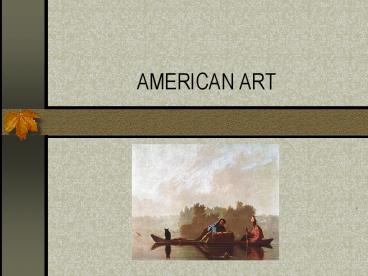AMERICAN ART - PowerPoint PPT Presentation
1 / 32
Title: AMERICAN ART
1
AMERICAN ART
2
Background pre-1825
- Portraiture
- European influence
- American Naive style
- Flat design, spare painting (Ammi Phillips,
1788-1865)
3
European influence
- John Singleton Copley, Paul Revere, 1768
4
Naïve style
- Ammi Phillips, Portrait of Harriet Campbell, 1815
5
Naïve style
- Edward Hicks, The Peaceable Kingdom (1834)
6
AMERICAN ROMANTICISM
- AFTER STYLE OF EUROPEAN ROMANTICS
- IDEALISTIC VISION OF AMERICA NEW GARDEN OF EDEN
- NOSTALGIA FOR PRE-ROMANTIC DAYS
- LANDSCAPES
- EXPANSION WESTWARD
- TRANSCENDENTALISM
7
Formal Principles of New Landscapes
- Not merely topographic but interpretive and
poetic views of nature - Depictions of harmony in nature
8
Subjects of New Landscapes
- Home in the Wilderness
- Juncture of civilization and wilderness
Wilderness on the doorstep - Incursions of civilization and progress
9
EMERSON THOUGHTS ON ART
- ARTISTS SHOULD PRODUCE WORKS OF ART FOR ALL MEN
AND PAINTING SHOULD BE A VEHICLE THROUGH WHICH
THE UNIVERSAL MIND COULD REACH THE MIND OF
MANKIND. ART IS NOT THE EXPRESSION OF THE
ARTISTS OWN FEELINGS.
10
Thomas Cole, The Hunters Return (1845)
11
Thomas Cole, Home in the Woods (1847)
12
Thomas Cole, Daniel Boone Sitting at the Door of
his Cabin on the Great Osage Lake, Kentucky, 1826
13
Style
- Juxtaposition of elements
- Use of panoramic views and small human figures to
show immensity of nature and insignificance of
human beings - Distant or elevated perspective for the viewer
- Symbolic use of light and darkness
- Contrast of diverse elements to show the unity of
nature
14
Thomas Cole, Scene from Last of the Mohicans
Cora Kneeling at the Feet of Tamenund (1827)
15
Thomas Cole, The Clove, Catskills (1827)
16
Sublime, Beautiful, Picturesque
- Longinus, On the Sublime (AD 50)
- Resulting from spirit--a spark from writer to
reader--rather than technique - Edmund Burke, Philosophical Inquiry into the
Origins of Our Ideas of the Sublime and Beautiful
(1757-1759) - Immanuel Kant, Critique of Judgment (1790)
- Beauty is finite the sublime is infinite
17
Thomas Moran, The Grand Canyon of the
Yellowstone, 1872
18
Albert Bierstadt, A Storm in the Rocky Mountains
(1866)
19
The Hudson River School
- Thomas Cole (1801-1848)
- Asher B. Durand (1796-1886)
- Thomas Doughty (1793-1856)
- John William Casilear
20
Thomas Cole (1801-1848)
- The subject of art should
- be pure and lofty . . .a moral,
- religious, or poetic effect
- must be produced on the mind.
21
Thomas Cole, The Ox-Bow (1836)
22
Asher B. Durand (1796-1886)
- Began as an engraver turned to painting
- Letters on Landscape Painting (1855) in The
Crayon - Go first to nature to learn to paint landscape.
23
Asher B. Durand, Kindred Spirits (1849)
- Thomas Cole and William Cullen Bryant
- See Bryants To Cole, the Painter, Departing for
Europe.
24
Panoramists and Luminists
- Second Generation of Hudson River school
- Style of Hudson River painters applied to other
regions - Rocky Mountains
- South America
25
Practitioners
- Jasper Cropsey (1823-1900)
- Frederic E. Church (1826-1900)
- John Frederick Kensett (1816-1873)
- George Inness (1825-1894)
- Albert Bierstadt (1830-1902)
26
Frederick Edwin Church
- Thomas Coles major pupil
- Full-length showpiece landscapes
- Falls of Niagara (1857)
- Heart of the Andes (1859)
- Landscape as symbol of divine
- American continent as new Eden
- Painted from nature, not notes and sketches
27
Frederick Edwin Church, Falls of Niagara (1857)
28
Twilight in the Wilderness (1860)
29
CHURCH, COTOPAXI
30
Albert Bierstadt, A Storm in the Rocky Mountains
(1866)
31
Albert Bierstadt, Yosemite Valley (1875)
32
WESTERN EXPANSION BINGHAM































